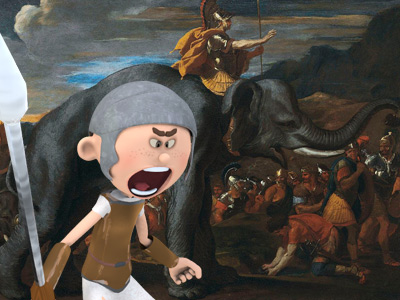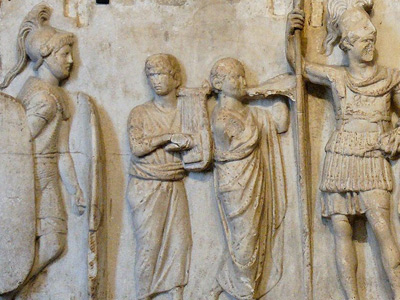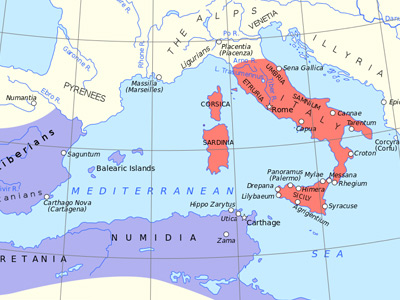First Punic War (264-241 BC)
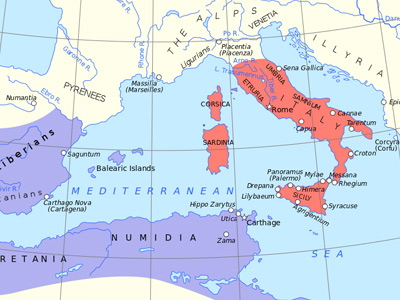
Beginning
In 288 BC, the Mamertines, a group of Italian (Campanian) mercenaries originally hired by Agathocles of Syracuse, occupied the city of Messana (modern Messina) in the northeastern tip of Sicily, killing all the men and taking the women as their wives. At the same time, a group of Roman troops made up of Campanian "citizens without the vote" also seized control of Rhegium, lying across the Straits of Messina on the mainland of Italy. In 270 BC, the Romans The Roman Republic was a form of government of Rome and the era of the classical Roman civilization when it was run through public representation of the Roman people. Beginning with the overthrow of the Roman Kingdom (traditionally dated to 509 BC) and ending in 27 BC with the establishment of the Roman Empire, Rome's control rapidly expanded during this period - from the city's immediate surroundings to hegemony over the entire Mediterranean world. regained control of Rhegium and severely punished the survivors of the revolt. In Sicily, the Mamertines ravaged the countryside and collided with the expanding regional empire of the independent city of Syracuse. Hiero II, tyrant of Syracuse, defeated the Mamertines near Mylae on the Longanus River. Following their defeat, the Mamertines appealed to both Rome and Carthage for assistance. The Carthaginians acted first, approached Hiero to take no further action and convinced the Mamertines to accept a Carthaginian garrison in Messana. Either unhappy with the prospect of a Carthaginian garrison or convinced that the recent alliance between Rome and Carthage against Pyrrhus reflected cordial relations between the two, the Mamertines, hoping for more reliable protection, petitioned Rome for an alliance. However, the rivalry between Rome and Carthage had grown since the war with Pyrrhus and that alliance was simply no longer feasible.
The Roman Republic was a form of government of Rome and the era of the classical Roman civilization when it was run through public representation of the Roman people. Beginning with the overthrow of the Roman Kingdom (traditionally dated to 509 BC) and ending in 27 BC with the establishment of the Roman Empire, Rome's control rapidly expanded during this period - from the city's immediate surroundings to hegemony over the entire Mediterranean world. regained control of Rhegium and severely punished the survivors of the revolt. In Sicily, the Mamertines ravaged the countryside and collided with the expanding regional empire of the independent city of Syracuse. Hiero II, tyrant of Syracuse, defeated the Mamertines near Mylae on the Longanus River. Following their defeat, the Mamertines appealed to both Rome and Carthage for assistance. The Carthaginians acted first, approached Hiero to take no further action and convinced the Mamertines to accept a Carthaginian garrison in Messana. Either unhappy with the prospect of a Carthaginian garrison or convinced that the recent alliance between Rome and Carthage against Pyrrhus reflected cordial relations between the two, the Mamertines, hoping for more reliable protection, petitioned Rome for an alliance. However, the rivalry between Rome and Carthage had grown since the war with Pyrrhus and that alliance was simply no longer feasible.
According to the historian Polybius, considerable debate took place in Rome on the question as to whether to accept the Mamertines' appeal for help and thus likely enter into a war with Carthage. The Romans did not wish to come to the aid of soldiers who had unjustly stolen a city from its rightful possessors, and they were still recovering from the insurrection of Campanian troops at the Battle of Rhegium in 271. However, many were also unwilling to see Carthaginian power in Sicily expand even further. Leaving them at Messana would give the Carthaginians a free hand to deal with Syracuse. After the Syracusans had been defeated, the Carthaginian takeover of Sicily would essentially be complete. A deadlocked senate put the matter before the popular assembly, where it was decided to accept the Mamertines' request and Appius Claudius Caudex was appointed commander of a military expedition with orders to cross to Messana.
HISTORY
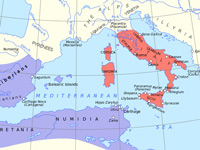
RESOURCES
This article uses material from the Wikipedia article "First Punic War", which is released under the Creative Commons Attribution-Share-Alike License 3.0.
© Stories Preschool. All Rights Reserved.
